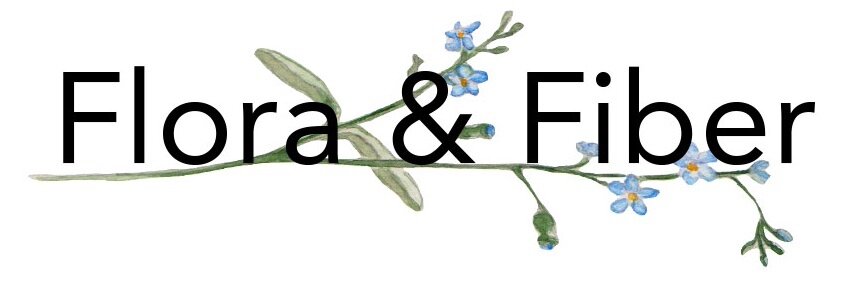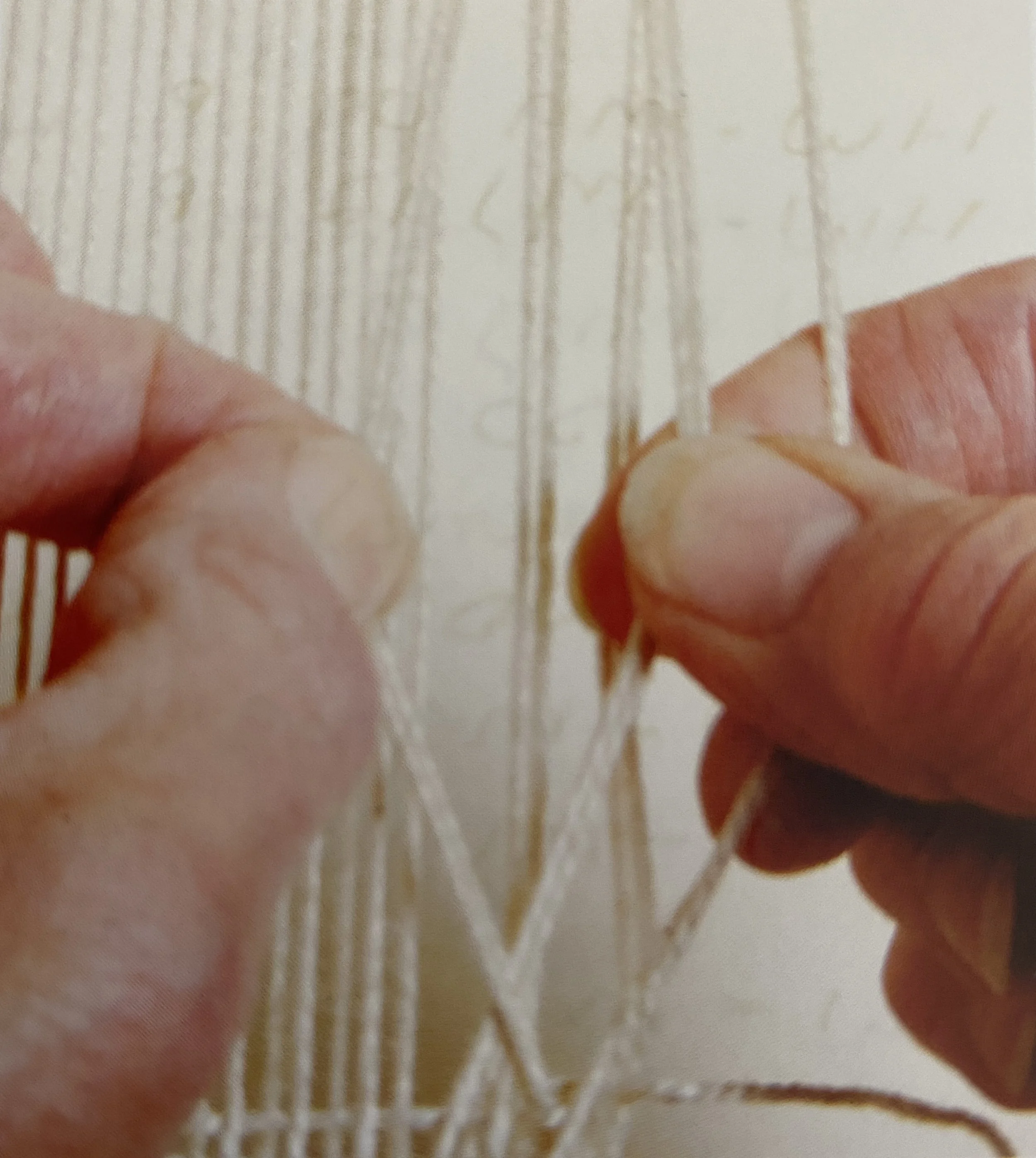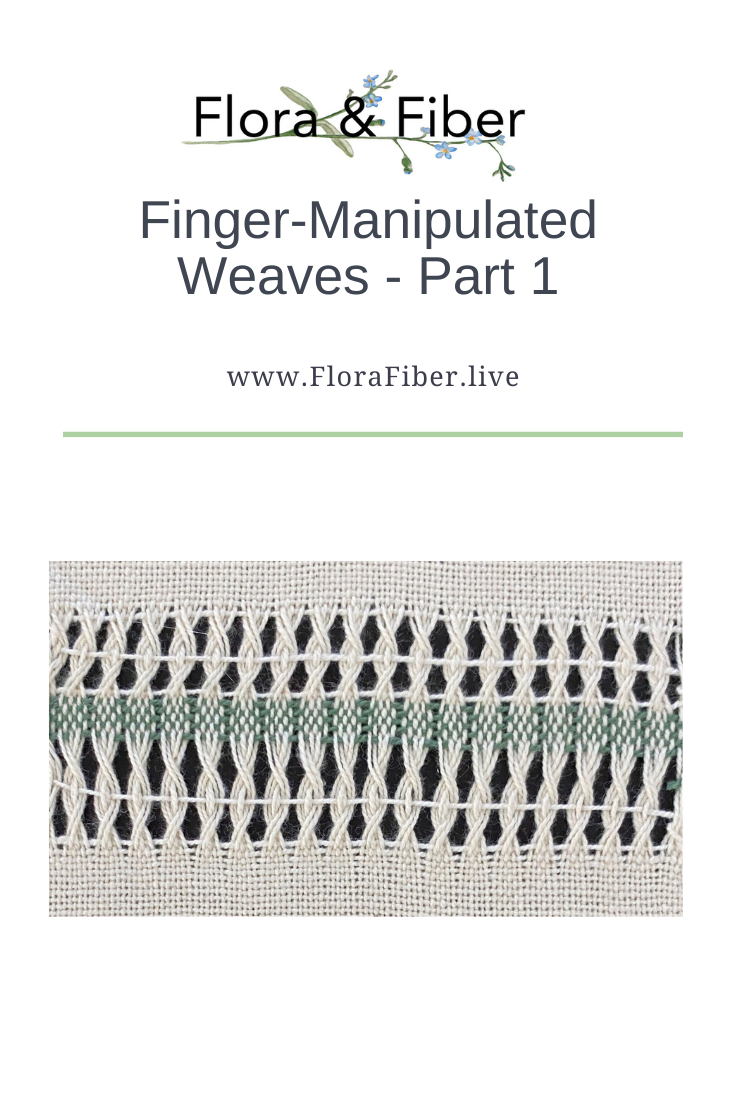Finger-Manipulated Weaves-Part 1
This post is the first offering for a series I've planned to look at finger-manipulated weaving techniques. Today's post describes the general attributes of these weaves. Then we'll explore two weaves: leno and its cousin, Mexican lace.
Finger-manipulated is a group of weaving techniques that, rather than the shafts on your loom managing the threads to achieve patterning, the weaver's fingers or a pick-up stick manipulates the threads. There are many different types and variations, each creating a different lacy effect. The weaves include leno, Brooks bouquet, Danish medallions, Spanish lace, and Mexican lace.
Typically in finger-manipulated techniques, there is a stabilizing weft, such as a tabby ground, woven before and after the lace section. Finger-manipulated lace techniques can be used in small areas or borders to accentuate other weave structures or as an all-over design. Possibilities include:
accent on garments
border on towels and table linens
curtains and window hangings
wall hangings
lacy shawls/wraps
Weaving Tips for Finger-Manipulated Weaves
One of the beautiful things about Finger-Manipulated Weaves is that they require only two shafts. Therefore they can be woven on a multi-shaft or a rigid heddle loom.
Uneven draw-in can be an issue with these weaves since the lace areas are commonly narrower than the background areas. Often a half-inch solid border at each selvage enhances the fabric structurally and visually. Spanish Lace is often used for this border (I will discuss Spanish lace in Part 2 of this series). Another tip is to loosen the tension when picking up the warp threads and allowing plenty of slack in the picks of weft.
Lace is relatively open and requires a light beat to create a balanced weave.
Yarns for finger-manipulated techniques are twisted around each other and must be strong and elastic. Thicker threads produce a more dramatic effect. Thinner threads create light and airy fabrics.
For those familiar with knitting or crocheting lace, you know that to see the full effect of the lace, the fabric needs to be wet-finished. It is the same in woven lace. Wet finishing allows the warp and weft threads to relax and distort into curves and spaces.
Leno
Leno (pronounced lee-no ) is the most predominant term for this type of finger-manipulated weave. However, I have also found it called antique Mexican, gauze, cross weave, and commercially as marquisette.
In leno, regardless of the variation, sets of warp threads are isolated and crossed, the crosses temporarily preserved on a pick-up stick, and a weft pick inserted to hold them in place. The twists may be 1/1, 2/2, 3/3, etc. (number of threads in each group). Think cables in knitting.
Samples
I wove these samples on a warp of 8/2 unmercerized cotton, natural (3360 yd/lb) at 20 epi. The warp is threaded as a straight draw and treadled as plain weave.
1/1 leno - 1 thread crossed over 1 thread, single row.
2/2 leno - 2 threads crossed over 2 threads, 3 rows.
3/3 leno - 3 threads crossed over 3 threads, 3 rows.
3-group leno on a closed shed - the thread crosses are typically done on an open shed (above samples). In this variation, the crosses are made on a closed shed. There are six threads per leno group; threads 1 and 2 are twisted over 5 and 6, then 3 and 4 are brought up between them. (see the photo at the top of the page with my fingers). Two rows of 3-group leno with five rows of plain weave in between.
2/2 leno twists in different directions - 1 row of adjacent sets of 2 threads crossed over 2 threads twisted in opposite directions, first to the left, the next set to the right, the next to the left, and so on.
Other Variations
change weft colors
add beads
ribbon through the leno spaces
double leno
five-end cross worked 1-3-1 with the center three above
4/4 leno
leno dashes, spots, and blocks
Greek leno (lace)
American leno
Peruvian leno
split groups on open & closed sheds
Karelian lace
Mexican Lace
Mexican lace is a variation of leno created by offsetting the pairs of twisted warp threads. It creates an even lacier look than leno.
Samples
1/1 Mexican lace - notice the offset compared with the 1/1 leno
2/2 Mexican lace - again, notice the difference by offsetting the start of the twisted threads.
Mexican lace combination - 1/1 (5 times); 2/2 (1 time); alternate 1/1 with 2/2 across warp; finishing with 1/1 (5 times).
1/1 Mexican lace (Peruvian gauze) - a lacy “hole” is formed by not crossing specific pairs of warp threads.
Variations
Surprisingly, there was not much I could find published on Mexican Lace. However, the same variations for leno would also work for Mexican lace.
Resources
Best, E. (2005). Lace by hand [free E-book available here]. great resource for all the finger manipulated lace weaves
Davenport, B. (1986, MA). Unusual ways with leno. Handwoven, 46-47, supplement 8. interesting Leno and Mexican lace variations.
Dixon, A. (2007). The handweaver’s pattern directory. Interweave. Lace Weaves, Hand Manipulated, 152-159.
Jarchow, D. (2018). Lovely lace market bag. Little Looms, 51, 61-63. cute leno project.
Patrick, J. (2010). The weaver’s idea book. Interweave. Chapter 2 Finger-Controlled Weaves, 42-77.
Spady, R. (2021, MJ). Leno. Heddlecraft, 6-15.
In Part 2, we’ll look at Spanish lace.



















